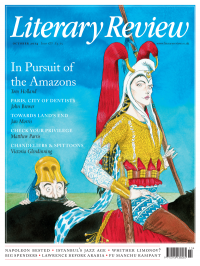Richard Canning
Laughter in the Dark
Tennessee Williams: Mad Pilgrimage of the Flesh
By John Lahr
Bloomsbury 765pp £30
‘The catastrophe of success’ was Tennessee Williams’s memorable response to his anointment as the undisputed – to Arthur Miller, ‘revolutionary’ – genius of American theatre, following the triumph on Broadway of The Glass Menagerie in 1945. The succinct phrase captures Williams’s temperament, which inclined towards paradox, and sometimes towards self-destructiveness. It also lays bare a naked, human truth: that success, ultimately, begets failure – or at best relative failure, by the very strength of the shadow cast by our highest achievements. Thomas Lanier Williams knew this as clearly aged thirty-four as he did later, when he saw himself, like Sisyphus, endlessly condemned to attempt the impossible – matching the creative force of his most celebrated works, which critics generally agree ended either with Cat on a Hot Tin Roof in 1955, Sweet Bird of Youth in 1959 or, most generous of all, The Night of the Iguana in 1961. (Even then, we have to take account of career missteps such as Camino Real in 1953 or the ridiculous cannibalistic plot of 1958’s Suddenly, Last Summer.)
There’s an agreeable wit in the coinage too, reminding us of something invariably overlooked in Williams’s nature: a dominant, all-encompassing, darkly subversive sense of humour. Famously, the dramatist was heard at the back of the theatre, laughing alone and uproariously at the climax of A Streetcar Named Desire, when the

Sign Up to our newsletter
Receive free articles, highlights from the archive, news, details of prizes, and much more.@Lit_Review
Follow Literary Review on Twitter
Twitter Feed
It wasn’t until 1825 that Pepys’s diary became available for the first time. How it was eventually decrypted and published is a story of subterfuge and duplicity.
Kate Loveman tells the tale.
Kate Loveman - Publishing Pepys
Kate Loveman: Publishing Pepys
literaryreview.co.uk
Arthur Christopher Benson was a pillar of the Edwardian establishment. He was supremely well connected. As his newly published diaries reveal, he was also riotously indiscreet.
Piers Brendon compares Benson’s journals to others from the 20th century.
Piers Brendon - Land of Dopes & Tories
Piers Brendon: Land of Dopes & Tories - The Benson Diaries: Selections from the Diary of Arthur Christopher Benson by Eamon Duffy & Ronald Hyam (edd)
literaryreview.co.uk
Of the siblings Gwen and Augustus John, it is Augustus who has commanded most attention from collectors and connoisseurs.
Was he really the finer artist, asks Tanya Harrod, or is it time Gwen emerged from her brother’s shadow?
Tanya Harrod - Cut from the Same Canvas
Tanya Harrod: Cut from the Same Canvas - Artists, Siblings, Visionaries: The Lives and Loves of Gwen and Augustus John by Judith Mackrell
literaryreview.co.uk